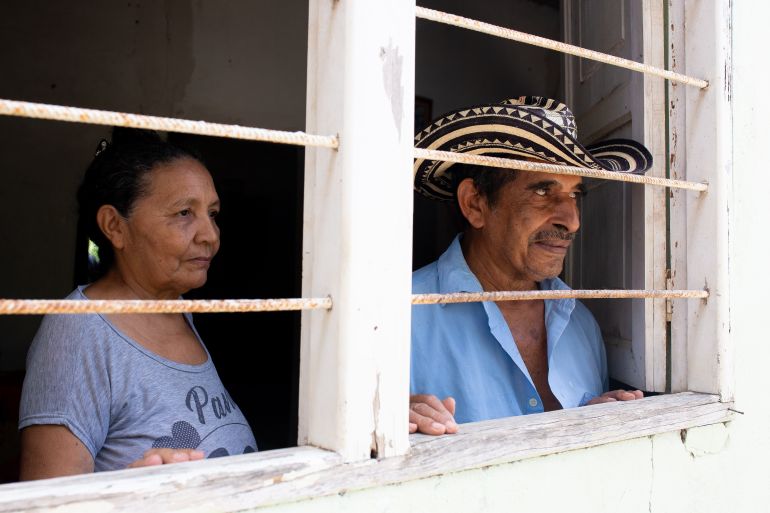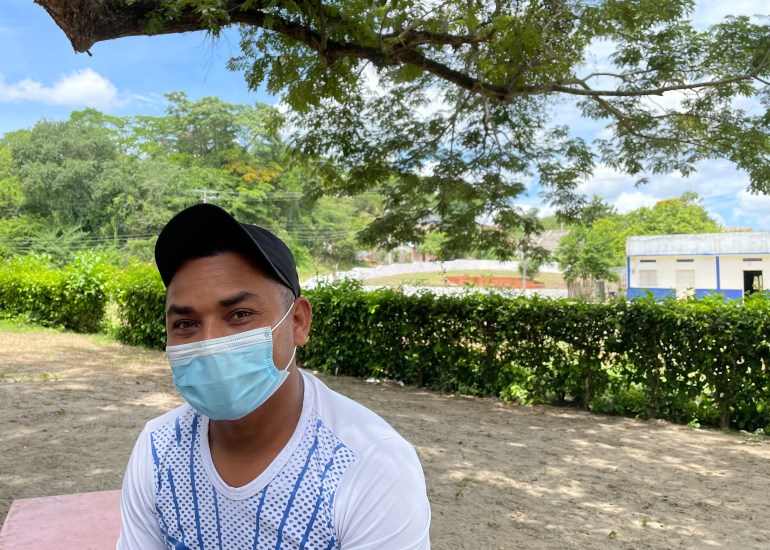Colombia’s ‘ghost towns’ threatened by new wave of violence
Paramilitary fighters forced many out of Colombian rural towns 21 years ago and those who returned fear it might happen again.

El Salado, Colombia – When Elias Torres, 76, walks the almost empty streets of his small town, the bodies that once scattered the dirt roads still haunt him.
A little more than 21 years ago, militias from the United Self-Defence Forces of Colombia (AUC) tore into El Salado. There, the right-wing paramilitary gang began to terrorise, torture and slaughter residents of the northern Colombian town.
Keep reading
list of 3 itemsClashes between anti-government protesters and police in Colombia
In Pictures: Violent protests erupt in Colombia
The militia killed at least 60 people, a number of reports put the death toll around 100. Many others were “disappeared”. After the massacre, the militia forced Torres to clear away the bloody corpses of his friends and family.
“You want to forget it, but you just can’t because it’s what we lived through in the flesh,” Torres remembered. “Imagine being forced to pick up the bodies of your friends because some armed group tells you ‘Get over here and pick up those dogs laying over there.’”
Thousands fled the town, leaving a mass grave and empty homes to decay in the stifling heat. Colombia’s decades of conflict turned El Salado along with many other towns across the South American country into pueblos fantasmas, or “ghost towns”.

As violence slowly subsided from the region, some residents like Torres and his family began to trickle back home. But the town now fears that history may once again repeat itself with armed-group violence surging in Colombia, a product of the country’s crumbling peace process.
“We still have to carry the weight of everything we lived through here, with this fear,” Torres said. “Your life isn’t safe anywhere if it is threatened. You aren’t safe anywhere.”
When hundreds of people returned home at the end of 2003, despite the state telling them it could not guarantee their safety, Yirley Velazco, another survivor from El Salado, said it looked like a completely new place.
“The day we returned to El Salado we couldn’t find our houses. Because of the thick weeds … we couldn’t see the houses,” she said.
Some like Velazco said they returned “out of love for the land.” Others like Torres returned because they were ostracised from society.
The paramilitaries who perpetrated the massacre in 2000 accused many of the civilians they killed of having links to their opponents, the Revolutionary Armed Forces of Colombia (FARC).

After the mass killing, Torres said these accusations followed him everywhere he went, and that he and his family were treated as though they were displaced because they were linked to an armed group.
Many more said fleeing to a new city, jobless and with nothing more than the clothes on their backs, created a crippling economic burden.
“I was barely scraping by,” said Torres. “All I brought with me were my family and my clothes. Nothing else, because we had to leave all our animals here.”
But in a country like Colombia, where peace has long been fragile at best, returning to communities like El Salado often comes with incredible risk. Elizabeth Dickinson, a Colombia researcher at the International Crisis Group, said such places “will always live in a shadow of fear”.
“In one of these pueblos fantasmas, basically the entire population, at one point or another, was marked as being aligned with one group or another or stigmatised,” Dickinson said. “That mark in many ways will never go away because everyone knows who everyone is.”
To this day, it still feels as if peace has never truly touched the lives of the massacre victims. Only 1,200 of the original 4,000 residents returned. The deteriorated facades of buildings speckle the small town.

Torres said he and his family never financially recovered.
In 2016, peace accords between the Colombian government and the FARC led the bloodshed to briefly subside.
However, the peace has crumbled in recent years and the government has failed to establish its presence in areas considered strategic for armed groups, leading to a new wave of violence to surge in much of the country.
The Montes de María region where El Salado lies is one of those strategic areas – a key trafficking route for drugs, illegal gold and more.
A diminished state presence in recent years has paved the way for a smattering of paramilitary groups to seize control. Chief among those in the region is a group calling itself the Gaitanista Self-Defence Forces of Colombia (AGC), more commonly known as the “Gulf Clan” or “Los Urabeños.” Others are smaller, fractured criminal gangs that have no interest in peace.
“The conclusion from our early warning system is that there has clearly been an increase in the presence of armed and organized groups, and this increased presence obviously translates into greater risk for those living in the area,” said Luis Andrés Fajardo, Deputy Ombudsman of Colombia, with the government agency in charge of protecting civil and human rights.
A rise in armed-group conflict earlier this year caused the number of people fleeing their homes in Colombia to more than double when compared with the same period in 2020, according to recent data by the United Nations.

Damaris Martínez, a lawyer who represents El Salado with the Colombian Legal Commission, echoed her concern about rising displacement figures, saying the situation in El Salado “has once again become very difficult.
[The violence] became much more visible at the end of last year,” Martínez explained. “And it increased at the beginning of this year, when threatening written pamphlets, text messages, WhatsApp messages, phone calls and extortion threats began to appear again to intimidate people.”
Already at least five families have fled El Salado. One of them was Velazco’s, which has received threats for her work as a community leader.
“They stuck a pamphlet through the door of my house and the threats were so bad that I decided to leave El Salado,” Velazco said. “I decided to leave everything behind for my safety and for the safety of my family.”
Other civilians from El Salado have decided to stay put and brave the rising security threats, rather than be displaced a second time. Emerson Ramos, 39, was 18 years old when the massacre happened in 2000.
His family decided to return because of the poverty they experienced after they fled, even though paramilitaries had killed his older brother in the town’s football field not far from where Ramos now lives.
Since 2018, his family has been under constant threat, and the family is unsure why they’ve been targeted. But signs of tension are everywhere. The streets of the town remain eerily empty, and armed soldiers stand in the back of a church service taking place in a plaza 20 feet (six metres) away.
While Ramos said he may leave one day, he does not want to flee like last time.
“What we lived through when we were displaced was very unpleasant. We couldn’t find any jobs, we had no stability,” he said. “It was very hard, so we don’t want to have to relive that.”